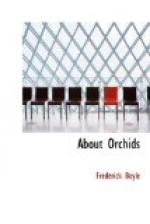I incline more and more to think that even genera may be disturbed in a surprising fashion, and I know that some great authorities agree with me outright, though they are unprepared to commit themselves at present. A very few years ago this suggestion would have been absurd, in the sense that it wanted facts in support. As our ancestors made it an article of faith that to fertilize an orchid was impossible for man, so we imagined until lately that genera would not mingle. But this belief grows unsteady. Though bi-generic crosses have not been much favoured, as offering little prospect of success, such results have been obtained already that the field of speculation lies open to irresponsible persons like myself. When Cattleya has been allied with Sophronitis, Sophronitis with Epidendrum, Odontoglossum with Zygopetalum, Coelogene with Calanthe, one may credit almost anything. What should be stated on the other side will appear presently.
How many hybrids have we now, established, and passing from hand to hand as freely as natural species? There is no convenient record; but in the trade list of a French dealer those he is prepared to supply are set apart with Gallic precision. They number 416; but imagination and commercial enterprise are not less characteristic of the Gaul than precision.
In the excellent “Manual” of Messrs. Veitch, which has supplied me with a mass of details, I find ten hybrid Calanthes; thirteen hybrid Cattleyas, and fifteen Loelias, besides sixteen “natural hybrids”—species thus classed upon internal evidence—and the wondrous Sophro-Cattleya, bi-generic; fourteen Dendrobiums and one natural; eighty-seven Cypripediums—but as for the number in existence, it is so great, and it increases so fast, that Messrs. Veitch have lost count; Phajus one, but several from alliance with Calanthe; Chysis two; Epidendrum one; Miltonia one, and two natural; Masdevallia ten, and two natural; and so on. And it must be borne in mind that these amazing results have been effected in one generation. Dean Herbert’s achievements eighty years ago were not chronicled, and it is certain that none of the results survive. Mr. Sander of St. Albans preserves an interesting relic, the only one as yet connected with the science of orchidology. This is Cattleya hybrida, the first of that genus raised by Dominy, manager to Messrs. Veitch, at the suggestion of Mr. Harris of Exeter, to the stupefaction of our grandfathers. Mr. Harris will ever be remembered as the gentleman who showed Mr. Veitch’s agent how orchids are fertilized, and started him on his career. This plant was lost for years, but Mr. Sander found it by chance in the collection of Dr. Janisch at Hamburg, and he keeps it as a curiosity, for in itself the object has no value. But this is a digression.




